Editor’s Note: This article dives into how we use Core & Meta Game alongside Defining Mechanics to define mobile game genres. Jump into our article New Genre Taxonomy and Why We Need It for a look at how our genre taxonomy helps you paint a crystal clear picture of the mobile gaming market.
Mobile game space has been experiencing significant leaps of evolution during the past few years. New game features, exotic feature implementations, and bold mixing of traditional mechanics have brought us plenty of fresh titles that have managed to rattle their own genre or even the industry as a whole.
This continuous innovation is now causing heavy pressure upon the traditional way of categorizing mobile games, as new games don’t often fit the old genre definitions so well. To give you one illustrative example of this, let’s take a brief look at the “Racing” category in the App Store and two of the genre’s popular titles: CSR Racing 2 and Real Racing 3.
It’s true that both these games are all about cars (= similar theme) and car tuning/upgrading (= similar metagame), but there are fundamental differences between their core gameplay mechanics. Unlike in Real Racing 3, in CSR Racing 2 you don’t actually steer and drive your car, but focus on “timely tapping” of your device, as your success is only dependent on switching gears (and maybe throwing in some nitrous-boost) at the exact right time. This divergence between the core game mechanics has, in turn, a huge impact on both CSR 2s and RR3s design, target audiences, and monetization structures.
Another, even more drastic example of the traditional game categorization’s shortcomings can be found from the App Store’s RPG-shelf, where single-character MMO’s and team-building focused JRPG’s are sitting next to puzzle/RPG hybrids, such as Puzzle & Dragons or WWE Champions.
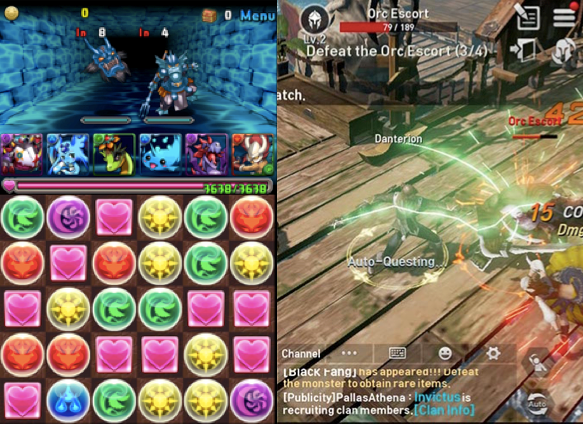
For most people, this “unfitting problem” is a minor annoyance at worst, but for anyone working in the industry, a more flexible and detailed categorization of games is needed. For that reason, we’ve developed a method that better captures the diversity of mobile games today. It’s based on three fundamental factors:
- Core game
- Meta game
- Defining Mechanics
FIRST STEPS – CORE & META GAME
Core game defines game’s basic gameplay mechanics, as it describes 1) what type of action takes place in the game and 2) how progress is made (i.e. levels are completed, monsters are defeated, etc.). For example, in typical RPG- and strategy games, the core game consists of fighting monsters or other players for dominance.
Meta game, on the other hand, defines the so-called “preparatory part” of the game, i.e. all the upgrading and enhancing done in order to improve the chances of success in the actual core game. In many strategy and RPG-games, for instance, you enhance your base or upgrade your characters in order to be more successful in fighting your opponents (= core game).
By using various core and meta game types, we’re able to depict games in a more diverse manner and capture their complexity better than by relying on the traditional static genre definitions. To highlight this, let’s take a look at some of the games we discussed above.
CSR Racing 2 and Real Racing 3 share the same meta game (Car development) but they differ in core game (tapping/timing vs. steering/directing). Through this differentiation, we’re able to put these two racing games in different brackets, which better emphasize their unique mechanics.
Similarly, we get a significantly better understanding of various RPG-games by looking at their core and meta games:
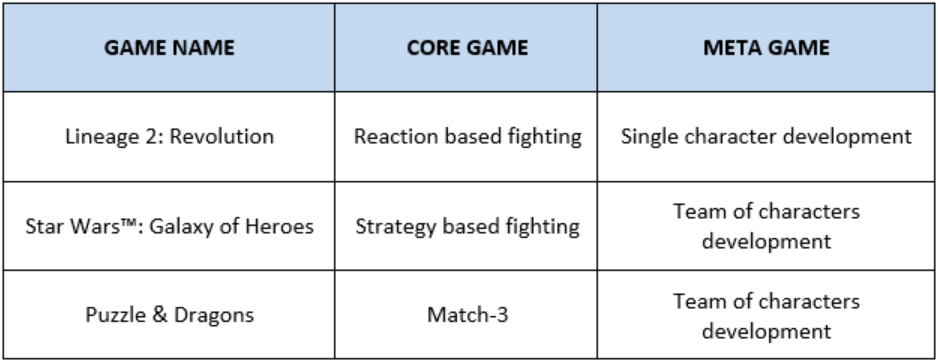
Another benefit of using this method is its flexibility. With our current system of 10 core and 6 meta game types, we’re able to tackle all kinds of hybrid games and new combinations of traditional game genres.
NEXT LEVEL – DEFINING MECHANICS
As illustrated, the core & meta approach helps us to categorize mobile games in a more accurate manner than the traditional App Store genres. However, in order to capture games’ essence even better and separate some specific game archetypes from their genre siblings, we’ve introduced Defining Mechanic features to our categorization approach.
Defining Mechanics are, as the name suggests, special characteristics that define the game’s distinct nature and mechanics in relation to other games of similar core and/or meta game. For example, both Game of War’s and Clash of Clans’ core game can be defined as “Strategy based fighting” and their meta games as “Hostile base construction” (as opposed to “Peaceful base construction). However, for anyone who’s spent more than five minutes with GoW and CoC, it’s clear that they are very different types of games, even though they share the same core and meta game types. By using Defining Mechanics, we’re able to distinguish Game of War as a “4X Strategy game”, which means its competitive landscape and target audience differs significantly from those of Clash of Clans.
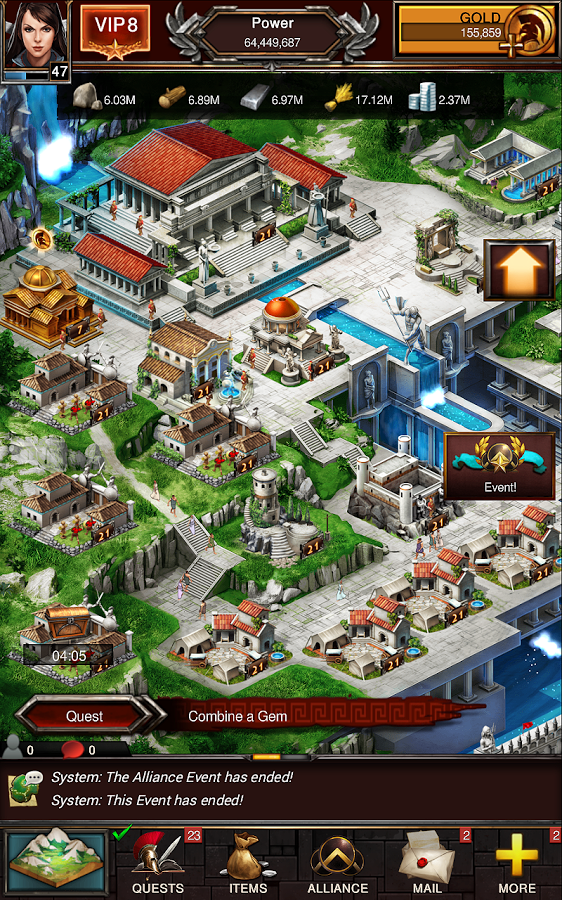
At the moment, we’re using 15 different Defining Mechanics ranging from “1on1 Brawler” (Marvel Contest of Champions), “Visual Novel” (Episode), and Deck-based CCG (Hearthstone) all the way to “MOBA” (Honor of Kings) and “MMO” (Lineage 2). As new game archetypes are pouring into the App Store, (e.g. the recent surge of battle royale survival games), we can easily introduce new Defining Mechanics into our model to better capture these titles’ true essence.
FULL PICTURE – SEEING THE WORLD IN A NEW LIGHT
Now that we’ve established this new method of categorizing mobile games, we can see its benefits when conducting market research. First, let’s revisit our Clash of Clans vs Game of War example and take a look at how 4X Strategy games differ from other builder-strategy games when it comes to monetization and market saturation:
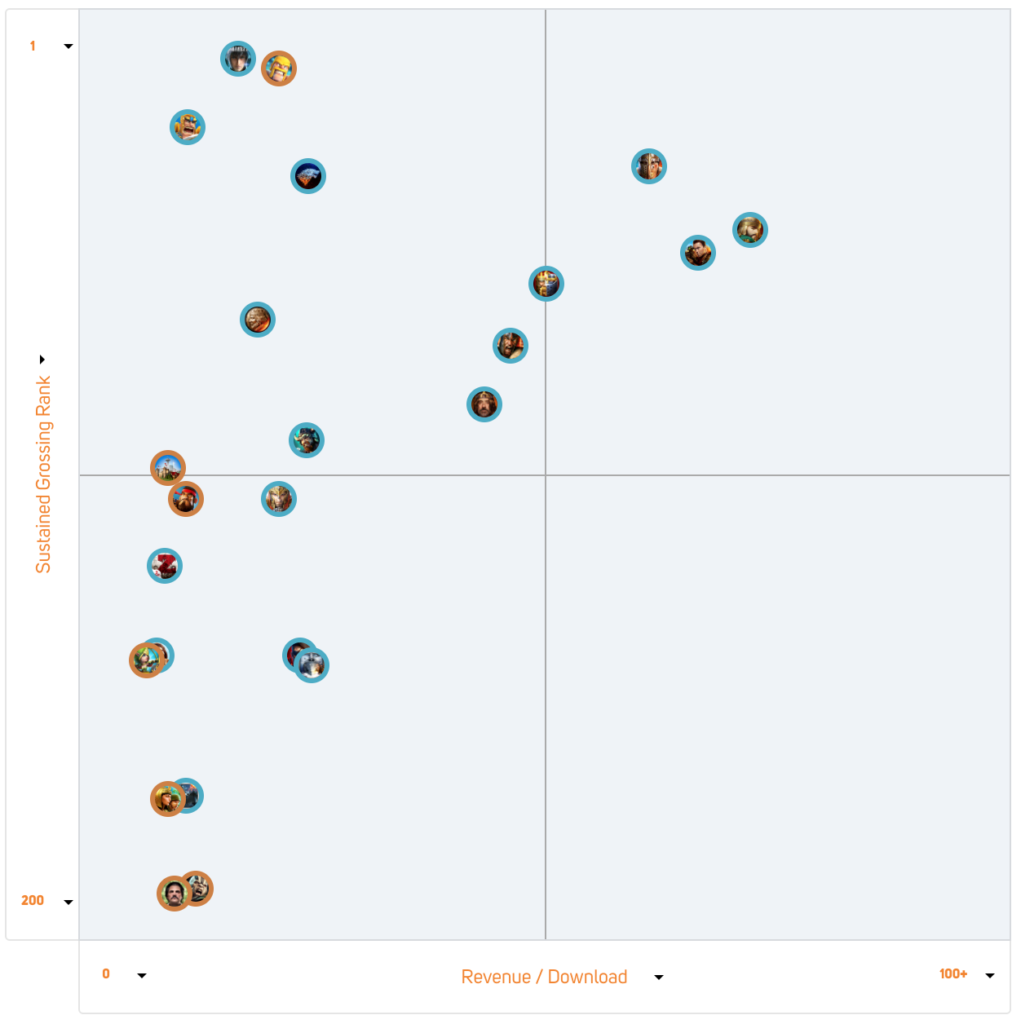
The graph above shows that:
- A total of 24 games with “Strategy based fighting” core game and “Hostile base construction” meta game have managed to sustain a Top-Grossing 200 position for the past 30 days in the US App Store.
- Out of those 24 titles, a whopping 17 are so-called 4X Strategy games (such as Game of War) and only 7 are other kinds of builder-strategy games.
- 4X Strategy games, in general, have a much higher revenue/download ratio, meaning they make more money from each download they get (estimated median revenue per download for these 4X’s is $21 for the past month, whereas it’s only $7 for the other builder-strategy games in the Top Grossing 200).
- Clash of Clans is the only non-4X Strategy game that has been able to sustain a steady Top Grossing 50 position during the past 30 days. This can be interpreted so that Clash of Clans is the undisputed king of its game type and it would be extremely difficult to try to penetrate that space with a new title.
- 4X Strategy games, on the other hand, are doing really well across the board and there’s enough demand in the market to sustain several top titles.
Our second example focuses on Match-3 puzzle games and this time we’ve split them into three different groups based on their meta game.
- Match-3 games with no meta layer
- Match-3 games with light building/construction meta
- Match-3 games with a team of characters development meta
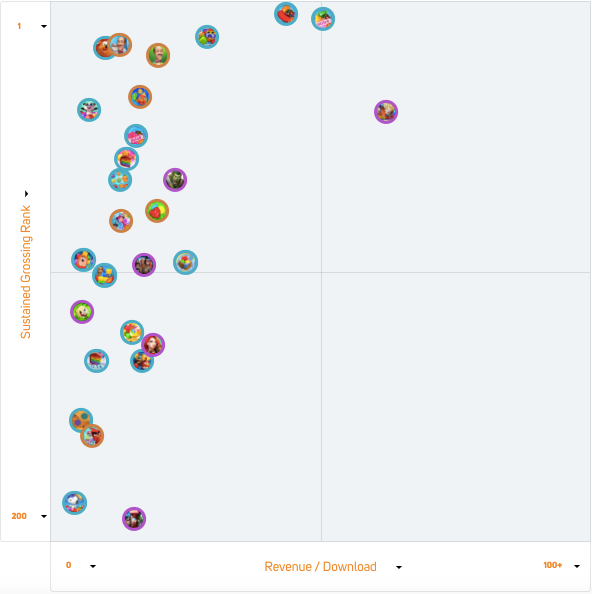
By looking at the graph, we can conclude that:
- A total of 28 games with Match-3 core-game have sustained a top-grossing 200 position for the past 30 days in the US AppStore.
- Out of those 28 games, 16 don’t have a meta layer at all (e.g. Candy Crush Saga), 6 have building/construction meta (e.g. Homescapes) and 6 utilize character development meta similar to RPG-games (e.g. WWE Champions)
- Within this game segment, building meta Match-3 as a group has the highest median revenue/download ratio ($14) for the past month, whilst Match-3s with no meta have the lowest median ($8). However, this “no meta” group includes games with the highest individual revenue AND revenue/download figures, meaning Match-3s with no meta layer have the largest deviation of performance in this segment.
- Even though there are several successful Match-3/RPG –hybrids, only Dragon Ball Z Dokkan Battle has been able to sustain an average Top Grossing 50 position during the last 30 days. Further investigation reveals that the main driver of its very high revenue/download ratio is derived from extremely effective monetization of live events and exclusive event characters.
CONCLUSIONS
As the mobile game market is getting more and more diverse, we’re in serious need of a new, more detailed, and flexible method of mapping our environment. In this article, I’ve introduced the use of core & meta game together with so-called Defining Mechanics as one useful way of tackling this challenge. By looking at games through the lens of these three dimensions, you’ll be able to see your game, its competitive field, and the whole mobile game space with its recent trends in a much more diverse and detailed light.
If you’re interested to learn more about mobile game trends and feature data, you can sign up for our web service for free here!






















